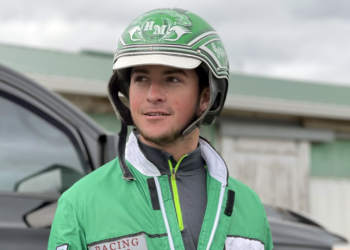My great friend, R. Philip Stern, will celebrate his 80th birthday on June 9.
We’ve known each other since the early 1960’s as we both spent our misspent youth at the bowling alley or the harness racing racetracks in Chicago.
 Being longtime members of the BDHC (Broken Down Horseplayers Club), we’ve shared a lifetime of stories regarding everything from our occasional winners to being nipped at the wire.
Being longtime members of the BDHC (Broken Down Horseplayers Club), we’ve shared a lifetime of stories regarding everything from our occasional winners to being nipped at the wire.
We’ve chatted about races and racing, and we have marveled at the speed shown on the tracks over the past decade or two and, being so used to a winning mile in 2:07 way back when, are still getting used to the sub-1:50 miles of today and the speed of the two-year-olds in this day and age.
We recently were discussing the speed parade and he said, “Harness racing is in such a hurry to get two-year-olds to go in 1:50, the focus just might be to get YEARLINGS to the races.
Truthfully, yearling races are nothing new and go back more than a century.
Heck, L. E. Brown used to conduct mail order yearling sales from his Maple Lawn Farm in Delavan, Illinois.
Mr. Brown invited prospective buyers to his farm to inspect the yearlings or, to save expenses, said he would sell the horses “sight unseen,” having shipped more than 2,000 horses—some over 1,000 miles—unattended—without one single loss!
Once the yearling was “knocked down” (sold), the cash transaction was completed and Brown even offered those that could not pick-up immediately “keep” at $15 per month at his farm or $50 per month at Springfield…also, $1 for each bale of hay, 50 cents for each sale of straw and 25 cents for the pail!
From 1911 through the early 1930’s, Brown sold his yearlings and included all pertinent information, including the yearling’s record as his trainer, Alex Wishart, put records on his yearlings for sale, including color, estimated height at maturity, bloodlines and a description including FLAWS.
On one 1924 bay filly named Shinefast, Mr. Brown advertised her trotting yearling record as 2:29 1/2—:34 with complete bloodlines and describing her as “trim, neat, smooth, stylish, muscular, correctly proportioned, superbly made, grand limbed filly.”
Trainer Alex Wishart then added, “is nice, kind, cheerful, good-mannered, splendidly gaited, four-cornered trotter.
“Took her record with less work than any trotter we ever had. Shows no nervousness, will leave a blanket on all night, likes company, is very tough and can go distances awful good.”
A list of her “future “engagements” followed, including the Hambletonian and Kentucky Futurity.
Brown would follow up his advertisements with MORE advertisements including one which read, “It’s not my fault that I am again advertising the 14 horses I now have for sale to you under the ‘You-Set-The-Price plan.” IT’S YOUR FAULT!
“It’s true,” he advertised, ‘none are so blind as he who will not see, YOU’VE PROVEN IT’”
Brown followed up with letters received from his satisfied buyers, one of which read, “Trampgalore arrived Saturday morning at 7 o’clock in first class condition. He looks even better than you represented him to me. Quite a few horsemen viewed him when he came in and all agreed that not a finer colt has come to this part of the country.
“Also received your check for $1.60, which I did not expect.”
Yes, L. E. Brown was one of the prominent yearling dealers over the past century…but, certainly, not the earliest.
The yearling filly Pride (Buccaneer) established the yearling record of 2:44 1/2 in San Francisco on November 5, 1881—a record that lasted only minutes when another filly, Hilda Rose (Electioneer) covered her mile in 2:43.
Nine days later, November 14, 1881, Hilda Rose annihilated her mark by trotting her mile in 2:36 1/2.
Her mark lasted for almost six years—October 15, 1887—until the filly Susie D (Hambletonian) went a mile in 2:35 3/4 in Lexington, KY.
Less than a month later (November 12, 1887), the filly Norlaine (Norval) chopped 4 1/4 seconds off the record with a 2:31 1/2 performance in San Francisco.
The first yearling colt to enter the select list was Freedom (Sable Wilkes) on October 18, 1891, piercing the 2:30 mark—2:29 3/4—in Napa, California on October 18, 1890.
The yearling filly Bell Byrd (Electioneer) lowered the mark twice—2:27 3/4 on October 6, 1891, then 2:26 1/4 on the 21st of that same month—in Stockton, California.
All of the above records were “against time,” except the Bell Byrd mile on October 6, which was in a race!
The chestnut filly Frou Frou (Sidney), competing in Stockton, California, had a memorable week beginning November 21, 1891, first, tying the record then, three days later, trotting in 2:26 and, four days after that, November 28, hitting the finish in 2:25 1/4.
On November 18, 1893, along came the chestnut mare Pansy McGregor (Fergus McGregor) and she trotted her mile in 2:23 3/4—in a race—in Holton, Kansas, setting a new standard for speed as a yearling.
Less than one year later, September 27, 1894, the colt Abdell (Advertiser) visited the track in San Jose, California and trotted a mile against time in 2:23.
Turning the page to the 20th century, yearlings were put to the speed test on both mile and half-mile ovals.
In 1912, Airdale (Tregantle) established a mark for colts of 2:15 3/4 while Anselilla (Prince Ansel) led the yearling fillies with a mark of 2:17 1/2 in 1915.
They even had a separate mark for the geldings, which belonged to Richard Moore (Guy Richard) at 2:22 1/2 set in 1931.
All three “records” were sent on mile tracks and, ironically, Airdale, Anselilla and Richard Moore were driven by H. C. Moody…almost two decades apart!
The black colt U. Forbes (J. Malcolm Forbes) set the yearling mark of 2:21 1/2 in 1913 and, he, too, was driven by H. C. Moody.
It was in the early 1900’s that yearling pacers joined the fray as the colt Frank Perry (Toddington) set the standard with a 2:15 mile in 1911.
It took 28 years to eclipse that record before Royal Lady 2nd (Bonnycastle) clipped a quarter second off that with a 2:14 3/4 time trial in 1939.
By the way, the aforementioned trainer Alex Wishart made the select list in 1921 when he drove the gelding The Scheme (The Exponent) to a yearling record of 2:21 3/4.
The agility and durability of the standardbred breed puts it in a category like no other with, not only yearling records on the books, but standards to wagon, under saddle, team-to-pole, three abreast, four-in-hand, heat racing (nine heats over three days the record) and distances of two miles, three miles, four miles, five miles, six miles, 10 miles, 18 miles, 20 miles, 30 miles, 32 miles, 50 miles and, finally, 100 miles—the latter with three different records noted on the books with the gelding Conqueror (Bellfounder) the holder of that unbreakable record in eight hours, fifty-five minutes and 53 seconds back in 1853.
- Phil has a whole slew of memories in his years…like when his very own Benevolent won at Maywood Park on March 24, 1979, in 2:05…to name one of a million.
And that’s what our grand sport offers—so far, well over two centuries of memorable moments that can never be erased from the minds of those who witnessed and received a lifetime of memories!
That’s what harness racing is all about—memories.
Happy 80, friend.
“May the Horse Be With You!”
by John Berry, for Harnesslink

 USA
USA Canada
Canada Australia
Australia New Zealand
New Zealand Europe
Europe UK / IRE
UK / IRE



